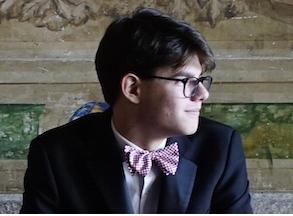The Alexander & Buono Foundation presents Thomas Nickell and Orchestra of the Swan in Review
The Alexander & Buono Foundation presents Thomas Nickell and Orchestra of the Swan
Thomas Nickell, piano
Orchestra of the Swan
David Curtis, conductor
Weill Recital Hall at Carnegie Hall
February 26, 2017
The collaboration of pianist Thomas Nickell and the Orchestra of the Swan, under conductor David Curtis, was a decidedly unorthodox and mostly refreshing change from the quotidian standard of current concert performances. In essence, this was an introduction to two entities, soloist and ensemble, who met at the juncture of two concerti, a standard from the repertory, and a fairly recent work by the English composer David Matthews.
Mozart’s Piano Concerto No. 12 in A major, K. 414/385p proved to be a savvy choice for an opener, as it allowed us to view the strengths of all the performers in a familiar, beloved work. Both the pianist and orchestra solved the acoustical challenges of the room and of the instrument to produce an overall warm, yet precise sound. Mr. Nickell is a composer as well, and his approach to the piano bespeaks a keen ear for harmony and structure. In much of this performance he chose to stay inside the piece, blending rather than competing with the strings. It worked like a charm. Perhaps in a nod to period practice, his cadenzas had a rhythmically flexible, somewhat improvisatory nature. Though not always entirely accurate, they were intelligent and thoughtful. For their part, the Swan paid close attention to nuances of phrasing and dynamic, providing beautiful and affectionate accompaniment for the soloist.
David Matthews’ Piano Concerto, op. 111 (2010), a terrific work in four movements, was the centerpiece of the program after intermission. The composer’s biography mentions Benjamin Britten as an influence, and this concerto was indeed reminiscent, in the best possible way, of the great English composer. While maintaining a strong, original voice, Mr. Matthews uses simple, lyrical melodies and folk dance rhythms to frame the individual movements of this work. His string writing, assured and inventive, was handled quite nicely by the Swan players, particularly the passage in harmonics at the close of the first movement. Mr. Nickell was again both partner and protagonist, showing a clear understanding and delight in this work.
As a bonus for Sunday’s audience the Orchestra of the Swan took their own solo turn in an impressive reading of Britten’s Variations on a Theme of Frank Bridge, Op. 10. Their conductor, David Curtis, prefaced the performance with an impromptu address in which he declared the orchestra’s love of New York City and of the piece they were about to play. No declaration was needed. The orchestra’s adherence to high standards and joy in playing was already abundantly apparent, and it was even more so apparent in the Britten. Despite the unforgiving acoustic in Weill Hall, where every lapse in intonation and ensemble stands out, the players succeeded in delivering a vibrant and richly colored set of variations, highlighted by a gossamer Romance and a thrilling, gutsy Aria Italiana. I must also mention the excellent solo contributions of both concertmaster and principal viola here, and in general throughout the concert.
Apart from the three orchestral selections, the remainder of the program featured Mr. Nickell in solo works by Messiaen, Cowell, Liszt, and himself. Of these, the four Messiaen preludes fit the pianist’s temperament like a glove. Messiaen’s explorations in harmony, color, and the spaces between music were beautifully evoked. His liberal use of both the sustain and una corda pedals was most effective here, and in the Cowell, a piece that is more difficult to bring off than it seems. Mr. Nickell’s own composition, entitled Sympathy, followed the compositional path of Messiaen, Arvo Pärt, and Toru Takemitsu. In a constricted range of dynamics from mezzo piano down to pianissimo and lower, silence played as large a part as sound. Again, Mr. Nickell’s radical approach to pedaling created some truly striking effects.
While the twentieth century piano works benefited from Mr. Nickell’s conceptualization, I feel the Liszt transcription of Wagner’s Liebestod from Tristan and Isolde was a misfire. The pianist’s self-effacing qualities were a handicap here, as he was frequently building up steam only to shift back into low gear. A more rhythmically propulsive and emboldened reading would have boosted it to another level. The only other concern regarding this program had nothing to do with the performances, but with the structure of the program, which was somewhat imbalanced, an impediment to an otherwise thoroughly professional and artistic venture.
Musicians such as Thomas Nickell and the Orchestra of the Swan, who place integrity and enjoyment above all else, are a rarity and a pleasure to encounter. I hope to hear them again soon.

